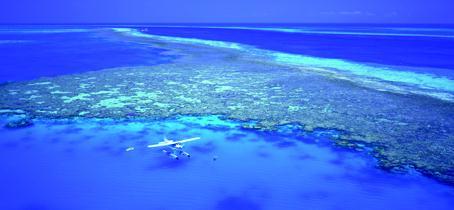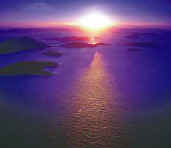July 8-12, 2002
The balmy Whitsunday Islands come just about as close to paradise as you could get, providing a perfect location for the IAU Symposium 213 Bioastronomy 2002: Life Among the Stars.
It is perhaps the only place on Earth where thousands of visitors can be at any one time, yet you can sail alone on the gentle trade winds, picnic on your own beach on islands untouched by development of any kind and anchor in inlets that look like Norwegian fjords. Wherever you go you are surrounded by the science of nature itself.
The real drawcard is the Great Barrier Reef that hugs this mostly national park island chain and the incredibly diverse wildlife. It’s the largest single reef system in the world, stretching 2,000 kilometres down the North East Coast of Australia and made up of almost 3,000 individual reefs, some up to 122 metres thick. There will be a full one-day conference trip to the Reef on Saturday July 13 at a cost of AUD$115 (US$57) including travel by jet cat ferry, exclusive use of a large platform facility with underwater viewing chamber, lunch, snorkelling and, for those who prefer not to get wet, semi-submersible trips.
The reef was built over millions of years by polyps, tiny creatures that join together to form underwater forests of coloured coral in fan, antler, brain and plate shapes. Each polyp is a jelly-like blob crowned by tentacles that give each individual an anemone-like appearance. They live in shells of aragonite, a type of calcium carbonate – the hard shell that forms the coral. It is the calcified remains of polyps that create the platforms to keep the living descendants in shallow, sunlit waters. The building of this giant reef system – visible from the Moon – is a feat equivalent to humans hand-building a mountain chain over 15 kilometres high.
Reef systems are perfect climate indicators. The polyps need lots of water movement, shallow, warm water no less than 20C and no greater than 30C, salty water that is low in nutrients and plenty of sunlight. They are incredibly sensitive to changes in these factors and in climate, probably being among the first to suffer from global warming and phenomena such as El Nino. Healthy reef is a myriad of colourful cities one could imagine as far distant worlds, and home to hundreds of species of brightly coloured tropical fish.
Dead coral is bleached white, stressed to death by environmental factors. Fortunately there is virtually no dead coral present on the Great Barrier Reef, perhaps at least partly because since the 1970s the reef and the Whitsundays have been protected by Australian law. Only and handful of resorts have been allowed to develop in the Whitsundays and even there, careful maintenance of the environment is a requirement to preserve the whole ecosystem of islands and reefs.
There are some 350 species of coral over 345 square kilometres. A string of the most famous of the platforms is within easy reach of Hamilton Island by fast Catamaran boat – Hardy Reef, Heart Reef, Hook Reef, Line Reef, Sinker Reef. At Hardy Reef a floating platform facility offers diving for beginners through to the experienced. For some the reef will provide the very first dive they have ever made. Snorkelling over the reef is also popular, while for those who don’t want to get wet there are trips along the reef in a semi-submersible boat and an underwater chamber to just sit and watch the reef at work and play.
July, when the Bioastronomy is being held, is a special month in the Whitsundays. It is when the Humpback whales, some with newborn calves, pass by, stopping to frolick in the sun on the trip south to Antarctic. It remains a mystery as to why the Humpbacks make the annual trip up the coast of Australia to its most northern tip, and then turn around to return to their summer grounds.
Other interesting wildlife includes the dugong, which grows up to three metres and can weigh up to 500 kilograms. Green turtles and dolphins also share this rich and diversified environment with 1,500 species of fish, 4,000 types of mollusc and 200 species of birdlife.
Captain Cook discovered the Whitsundays on June 3, 1770. His ship Endeavour almost foundered on the reef – a sobering thought that history might well have taken an entirely different course had Cook, his crew and the ship not survived. Cook named the islands after the date in his calendar, noting the islands were ‘diversified by hill and valley’ enveloped in trees and ‘of a pleasant appearance’.
The islands were once part of the Queensland coast, ripped away by volcanoes and earthquakes in a long distant and violent past. Today what the visitor sees are the tree-covered eroded tips of a mountain chain drowned by rising sea levels – the same rise that caused the reef to build upwards towards the sunlight.
The largest, and uninhabited, island is Whitsunday itself, strung with one of the purest white beaches in the world. Whitehaven Beach is kilometres of 99 percent pure silica – so pure that simple melting will produce clear glass. It provides a perfect spot to drop anchor and go ashore for a walk, swim or picnic.
Hamilton Island contains the largest of the small resorts scattered through the islands. It has a range of accommodations, eight swimming pools, nine restaurants offering light snacks to fine dining, mixed business shops and takeaway food. Few cars exist on the island – the main form of transport is golf kart buggy. The island hosts up to 2,000 people at any one time and around 200 boats in its world class marina, yet even it seems hardly anyone is around.
The island has a 50-acre fauna park with kangaroos and koalas. A key feature of the resort is the eucalypt bush walks to the peaks that allow 360-degree views of the islands. Hamilton has fringing coral right on its doorstep with some of the best snorkelling and diving from Catseye Beach.
To reach Hamilton is simple. A domestic jet flight direct from Sydney, Brisbane or Cairns will whisk you there – and while you sip a cool drink on your balcony or patio listening to the gentle lapping of the Coral Sea your bags will be delivered straight from the jet hold.
* July is in the Southern Hemisphere winter, but the latitude of the islands ensures warm days of around 23 degrees Centigrade and low rainfall. You need pack only light clothes with a sweater or light track suit for the cooler evenings. The climate is similar to that of Hawaii.
Carol Oliver

Part of the Great Barrief Reef near Hamilton Island


